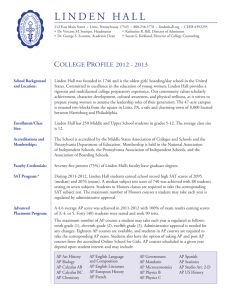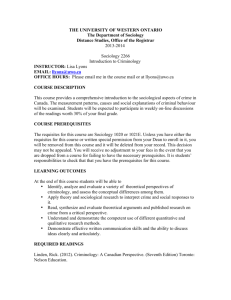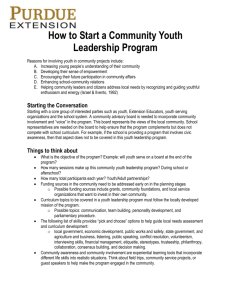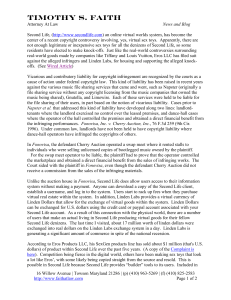Second Life: It's not a game
advertisement
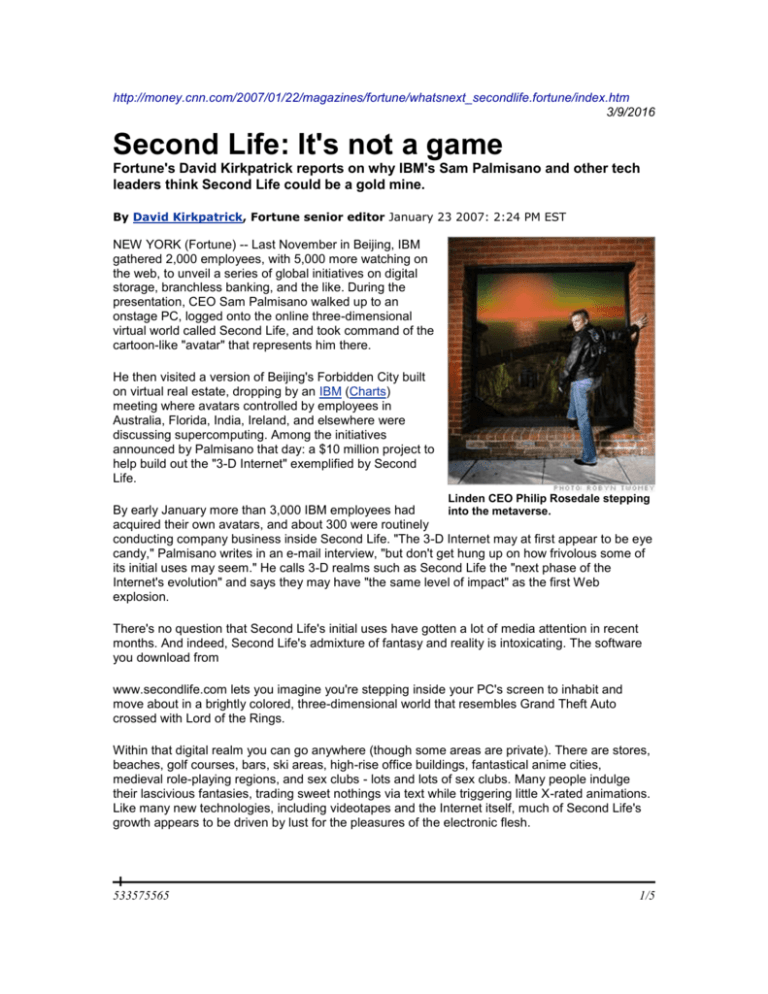
http://money.cnn.com/2007/01/22/magazines/fortune/whatsnext_secondlife.fortune/index.htm 3/9/2016 Second Life: It's not a game Fortune's David Kirkpatrick reports on why IBM's Sam Palmisano and other tech leaders think Second Life could be a gold mine. By David Kirkpatrick, Fortune senior editor January 23 2007: 2:24 PM EST NEW YORK (Fortune) -- Last November in Beijing, IBM gathered 2,000 employees, with 5,000 more watching on the web, to unveil a series of global initiatives on digital storage, branchless banking, and the like. During the presentation, CEO Sam Palmisano walked up to an onstage PC, logged onto the online three-dimensional virtual world called Second Life, and took command of the cartoon-like "avatar" that represents him there. He then visited a version of Beijing's Forbidden City built on virtual real estate, dropping by an IBM (Charts) meeting where avatars controlled by employees in Australia, Florida, India, Ireland, and elsewhere were discussing supercomputing. Among the initiatives announced by Palmisano that day: a $10 million project to help build out the "3-D Internet" exemplified by Second Life. Linden CEO Philip Rosedale stepping By early January more than 3,000 IBM employees had into the metaverse. acquired their own avatars, and about 300 were routinely conducting company business inside Second Life. "The 3-D Internet may at first appear to be eye candy," Palmisano writes in an e-mail interview, "but don't get hung up on how frivolous some of its initial uses may seem." He calls 3-D realms such as Second Life the "next phase of the Internet's evolution" and says they may have "the same level of impact" as the first Web explosion. There's no question that Second Life's initial uses have gotten a lot of media attention in recent months. And indeed, Second Life's admixture of fantasy and reality is intoxicating. The software you download from www.secondlife.com lets you imagine you're stepping inside your PC's screen to inhabit and move about in a brightly colored, three-dimensional world that resembles Grand Theft Auto crossed with Lord of the Rings. Within that digital realm you can go anywhere (though some areas are private). There are stores, beaches, golf courses, bars, ski areas, high-rise office buildings, fantastical anime cities, medieval role-playing regions, and sex clubs - lots and lots of sex clubs. Many people indulge their lascivious fantasies, trading sweet nothings via text while triggering little X-rated animations. Like many new technologies, including videotapes and the Internet itself, much of Second Life's growth appears to be driven by lust for the pleasures of the electronic flesh. 533575565 1/5 http://money.cnn.com/2007/01/22/magazines/fortune/whatsnext_secondlife.fortune/index.htm 3/9/2016 None of that is created by Linden Lab, the 110-employee San Francisco company behind Second Life. It's all hatched by the users. Indeed, members invent not only the world but themselves: Each person dreams up his own avatar. A control panel allows you to adjust your avatar's body, including eye color, cheek thickness, pant length, and girth. You can make it resemble your real self, or someone - or something - else. Want to look like Britney Spears? No problem. Perhaps you'd like to be a crocodile with a chef's hat? You can do that too. Once you've designed yourself, you can walk around the virtual world, using the arrow keys on your keyboard. If you'd prefer, you can fly. You see the world on your screen from the vantage point of your avatar. One thing you'll always see: a lot of other avatars. It's a highly social medium. Linden CEO Philip Rosedale stepping into the metaverse. That's a big part of Second Life's allure. If the Web offered people the liberation of communicating with almost anyone, Second Life gives you the chance to meet people in wildly varying contexts, and do it in a body you created. (This may explain why so many avatars appear buff, invitingly dressed, and about 20 years old.) It offers endless social possibilities with people around the globe - text chat is ubiquitous, and voice conversation is coming - and the sort of exploration that keeps its fans glued to their screens for hours. This virtual world - don't call it a game - has become a phenomenon: Second Life, which is free for casual use, has about 334,000 regular visitors. More than 2.6 million have checked it out, a figure that in mid-January was growing by about 20,000 per day. But what's beginning to catch the attention of IBM and other huge corporations is something potentially far more profound than a new online pastime. It's the ability to use Second Life as a platform for a whole new Net this one in 3-D and even more social than the original with huge opportunities to sell products and services. Rosedales avatar is edgier than the actual Linden Lab CEO. Bill Gurley, a venture capitalist with Benchmark Capital, says he invested in Second Life because it's like Microsoft (Charts) or eBay (Charts) - a venue in which thousands of ancillary businesses can sprout. (Gurley, a former Fortune columnist, is now on Linden's board.) The company's backers include some of the world's smartest, richest, and most successful tech entrepreneurs. The chairman and first big outside investor is Mitch Kapor, creator of Lotus 1-2-3, the spreadsheet application that helped begin the PC software revolution. Other investors include eBay founder Pierre Omidyar, Amazon (Charts) CEO Jeff Bezos, and Microsoft chief technology architect (and inventor of Lotus Notes) Ray Ozzie - each credited with a seminal networked product of our age. 533575565 2/5 http://money.cnn.com/2007/01/22/magazines/fortune/whatsnext_secondlife.fortune/index.htm 3/9/2016 They think Second Life may be next, and some respected tech pundits agree. Says Mark Anderson, author of the Strategic News Service newsletter: "In two years I think Second Life will be huge, probably as large as the entire gaming community is today." In the case of IBM, it's not just a matter of touting the wonders of Second Life; it's really using it - both as a business opportunity and as an internal tool. Ian Hughes, one of the company's "metaverse evangelists" - an actual title - says Second Life stimulates collaboration among a dispersed workforce. ("Metaverse," a word coined by Neal Stephenson in his 1992 novel, Snow Crash, is gaining currency as the generic name for virtual worlds.) "We're all used to teleconferences," says Hughes. "But in Second Life we gather and mingle before the meeting, and when it finishes, some people stop and talk again. We start to form social networks and the kinds of bonds you make in real life." Hughes, whose Second Life handle is ePredator Potato, often attends IBM meetings as a pudgy avatar with spiky green hair. Sam Palmisano's avatar inside one of IBM's Second Life properties But while the immersive 3-D environment that Second Life is pioneering could shape the way we interact online, it's not certain that Linden Lab will be the main beneficiary. Second Life's software is so hard to use that fewer than one in six who try it are still online 30 days later. Linden's servers frequently falter under the weight of its growing audience, and critical functions such as search sometimes break down. Though Second Life is the biggest virtual world, the company remains minuscule - 2006 revenues were less than $11 million - and competitors are nipping at its heels. They, too, smell opportunity. When Second Life opened in June 2003, there was nothing there, nowhere to go, and nobody to see. CEO Philip Rosedale had made the surprising decision to leave Second Life empty. Colleagues argued for inventing a game to show what was possible, but Rosedale, now 38, thought the service would work best if it let users create their own world. Says venture capitalist Jed Smith, an early investor who sits on Linden's board: "We decided then to be a platform and not a game." Not incidentally, that meant Linden - unlike the purveyors of popular online games such as World of Warcraft - wouldn't have to spend any money creating its content. At first, Second Life seemed destined for oblivion. Only 1,000 people were regularly visiting after five months, and money was running out. Smith and Kapor, who had invested the lion's share, considered pulling the plug. But they were astonished by the creativity of Second Life's few denizens. They were dreaming up cities, jungles, games, clubs and all manner of idiosyncratic avatars. Impressed by this passion, Kapor wrote another seven-figure check, and Second Life relaunched in January 2004, this time with more focus on user creativity and in-world entrepreneurship. Linden took the advice of Lawrence Lessig, the Stanford Law School guru on intellectual property, who recommended letting users own their own content. That, he argued, would encourage them to create more. 533575565 3/5 http://money.cnn.com/2007/01/22/magazines/fortune/whatsnext_secondlife.fortune/index.htm 3/9/2016 The company also made it possible to exchange Second Life's currency, called Linden dollars, for the real thing (taking a fee along the way). Residents could thus build, own, or sell their digital creations. Second Life had become a real economy. And Linden changed its business model. It began generating revenues primarily from the sale of virtual land. So far Linden has sold 3,500 private islands, each equivalent to 16 acres in the real world. (The world inside Second Life currently occupies about 150 square miles. But it's growing, and as population increases, Linden simply creates more digital real estate.) Each island costs $1,675 to purchase and $295 monthly to maintain; some buyers subdivide their land and rent or sell it at a profit. In essence, customers are renting space on the 1,750 servers that store the digital representation of the land. One of the biggest landowners is IBM, which rules over 24 islands. Since Linden revamped its business model to focus on real estate, users and revenues have grown at least 10 percent every month. In this realm any resident can become an entrepreneur. There are nightclub owners, jewelry makers, landscapers and even pet manufacturers. In December, Linden Lab estimated that 17,000 residents had positive cash flow in Linden dollars, with about 450 generating monthly income in excess of $1,000 (that's U.S.). One resident, whose avatar is known as Anshe Chung, has become a celebrity of sorts by claiming to have accumulated a real-world net worth of more than $1 million in Second Life real estate. She now employs 30 people in China who build things and otherwise improve the land she buys and develops for resale. Another Second Lifer developed a gambling game called Tringo, a cross between Tetris and Bingo. It became so popular that it has been licensed for Nintendo's Game Boy advance. These days, about $600,000 is spent daily throughout Second Life, for an annual GDP of about $220 million. Some of that money is going to Nike (Charts), Sony BMG, Toyota (Charts), Sun, Starwood, and many others, which have operations in Second Life. Some sell virtual clothing and other merchandise for avatars; some even move real product. IBM has built stores for Circuit City and Sears, where, for example, you can mock up a kitchen with Sears appliances to see how it would look. ABN Amro, the Dutch bank, recently opened an office in Second Life that will offer information about products and services as well as job openings. (Experts are already warning companies to avoid the pushy, ham-handed early Web marketing that enraged Net devotees. Second Lifers have taken flaming to new levels of imagination: One group that opposes virtual real estate development pelted Anshe Chung with a barrage of flying phalluses.) All these enterprises need guidance and help building things. Linden Lab counts 65 companies that have sprung up inside Second Life to serve real-world business customers. CTO Cory Ondrejka says about 350 people work full-time for such companies, and there are at least $10 million worth of such projects underway. For now Linden is enjoying its moment in the limelight and trying to cope with the infrastructurestraining influx of new visitors. That's not a minor problem: If its servers crash or its software is hard to use, Linden risks missing its chance to enchant millions of new users. In part to address that, and because of its belief that customers should be in control, Linden has taken another 533575565 4/5 http://money.cnn.com/2007/01/22/magazines/fortune/whatsnext_secondlife.fortune/index.htm 3/9/2016 radical step: It announced that the software that residents use to view and navigate Second Life would become available for anyone to examine and modify. The aim is to speed up improvements. Eventually Linden intends to reveal the code for every aspect of Second Life. CEO Rosedale hopes that other companies' virtual worlds will interoperate with Second Life. That could benefit Linden so long as it remains the biggest operator. "Say IBM uses our code to build its own intranet version that's somewhat different from Second Life," he says. "A user may say 'Wow, this virtual thing IBM has built is pretty cool. Now I want to go to the mainland.' And we have another customer." In effect, Linden hopes to control the standards for virtual worlds so that they become the equivalent of the HTTP and HTML standards that define the web. That could lead to what Rosedale thinks will be Linden's greatest long-term opportunity: running some of the lucrative services necessary to keep all these linked virtual worlds functioning smoothly. "We can recreate Google's business in this environment," Rosedale says, not to mention Network Solutions' web-address registration business and Paypal's online-payments system. Easier said than done, of course. Metaverses will become a very competitive field, says Irving Wladawsky- Berger, vice president for technical strategy at IBM. These are just the earliest days of exploration, and needless to say, the outcome is anything but certain. "Today," says Wladawsky- Berger, "virtual worlds are where video and VCRs were in the early 1980s, or where the Web was in 1993." 533575565 5/5
